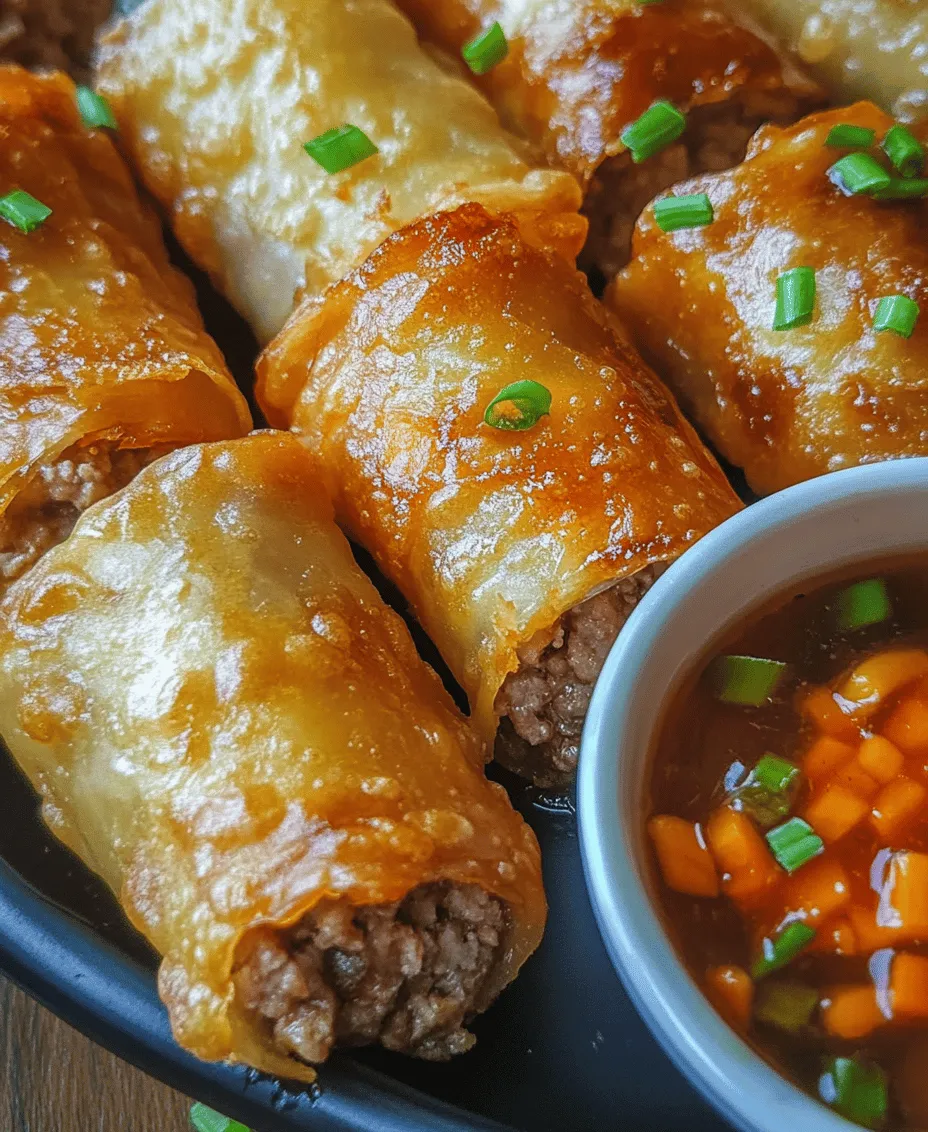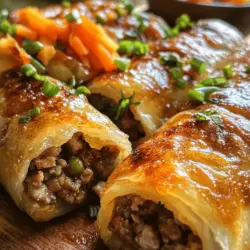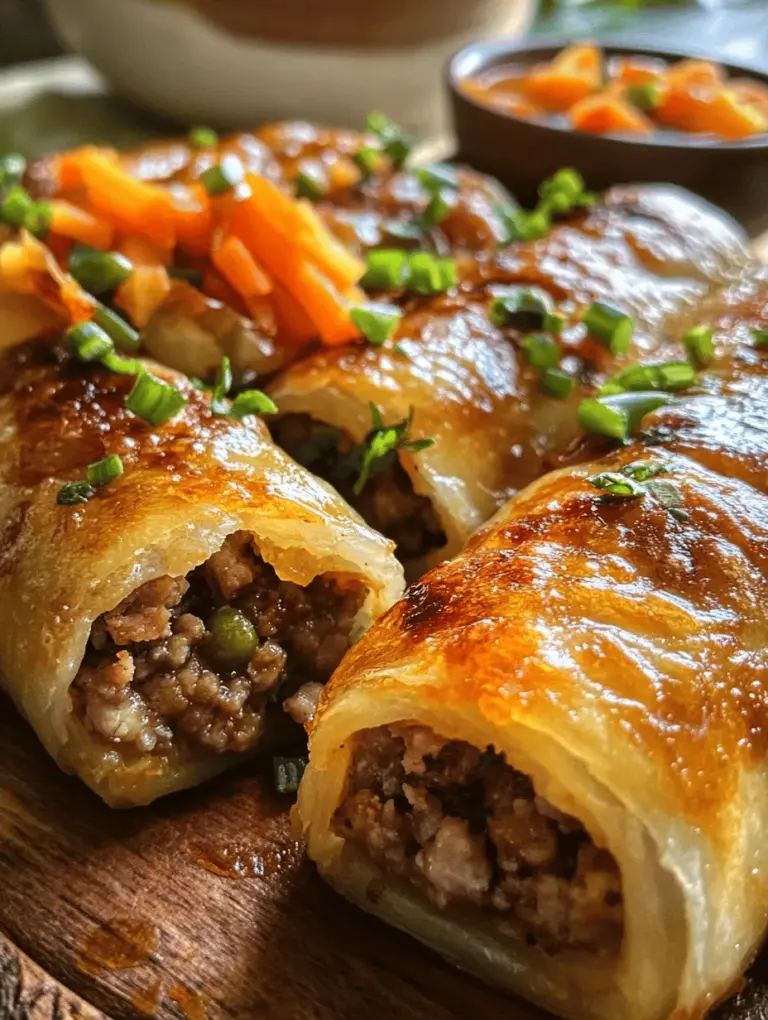Explore the delightful world of Filipino cuisine with a recipe that embodies the essence of comfort food: Crispy Delight Filipino Lumpia. This beloved dish, often shared during family gatherings and celebrations, combines a medley of flavors and textures that are sure to please any palate. Whether you’re a seasoned cook or just starting your culinary adventure, this guide will provide you with everything you need to create these delectable crispy spring rolls from scratch.
Lumpia, the Filipino version of spring rolls, is not just a dish; it’s a cultural symbol that resonates deeply within the Filipino community. From festive occasions to everyday meals, lumpia is a staple that brings people together. In this article, we will take you through an in-depth guide to making these crispy delights, including insights into their cultural significance, preparation methods, and serving suggestions.
Understanding Lumpia: A Cultural Overview
The Origin of Lumpia in Filipino Cuisine
Lumpia has its roots in the culinary traditions of China, where spring rolls originated. As Chinese immigrants settled in the Philippines, they brought with them their culinary practices, which eventually blended with local ingredients and flavors. Over the years, lumpia evolved into a distinctly Filipino dish, showcasing the country’s rich agricultural produce and diverse flavors.
In the Philippines, lumpia is often filled with a mixture of meat, vegetables, and spices, encased in a thin wrapper, and then deep-fried to a golden crisp. The most common type, Lumpiang Shanghai, is filled with ground pork, vegetables, and seasonings, making it a favorite at parties and special occasions. However, lumpia is not limited to one specific filling; it varies greatly across regions, reflecting the local ingredients and preferences.
Variations of Lumpia Across Southeast Asia
While lumpia is a beloved dish in the Philippines, it is just one of many variations of spring rolls found throughout Southeast Asia. In Indonesia, for example, Lumpia Semarang features a filling of shrimp and chicken, wrapped in a thin crepe-like skin. In Vietnam, the famous Gỏi cuốn, or fresh spring rolls, are made with rice paper and filled with fresh herbs, vermicelli noodles, and a choice of protein.
Each variation showcases the diverse culinary influences and techniques of the region, making lumpia a versatile and adaptable dish. Regardless of the specific ingredients used, the essence of lumpia remains the same: a delicious, crispy snack that is perfect for sharing.
The Role of Lumpia in Filipino Celebrations and Gatherings
In Filipino culture, food plays a crucial role in bringing people together, and lumpia is often at the center of these gatherings. Whether it’s a birthday celebration, a wedding, or the traditional holiday feast, lumpia is a must-have dish that guests look forward to. Its crispy exterior and savory filling make it an irresistible appetizer or side dish.
Beyond celebrations, lumpia is also a common feature in everyday meals. It can be enjoyed as a snack, served with rice and dipping sauces, or even packed in lunchboxes for a delicious on-the-go option. The versatility of lumpia makes it a beloved staple in Filipino households, cherished for its ability to satisfy cravings and foster connections.
Ingredients Breakdown
Creating the perfect Crispy Delight Filipino Lumpia starts with understanding the ingredients that make this dish so special. Let’s break down the essential components needed for this recipe.
Overview of Main Ingredients
The main ingredients for Lumpia typically include:
– Ground meat (pork or chicken)
– Fresh vegetables (carrots, onions, green beans, etc.)
– Seasonings (garlic, salt, pepper, soy sauce)
– Spring roll wrappers
These ingredients come together to create a harmonious balance of flavors and textures that make lumpia a favorite among many.
Ground Pork or Chicken: Choosing the Right Meat
When it comes to the meat for your lumpia, both ground pork and chicken are popular choices. Ground pork tends to be more flavorful and is often preferred for traditional Lumpiang Shanghai. It has a higher fat content, which helps keep the filling moist and adds to the overall flavor of the dish.
On the other hand, ground chicken is a lighter option and works well for those looking for a healthier alternative. It’s essential to choose high-quality meat, whether pork or chicken, to ensure the best taste and texture in your lumpia.
Vegetables: The Importance of Freshness and Texture
Fresh vegetables play a crucial role in the filling of your lumpia. Commonly used vegetables include:
– Carrots, finely chopped or julienned
– Green beans, cut into small pieces
– Cabbage, shredded
– Onions, diced
Using fresh vegetables not only enhances the flavor of the filling but also adds a satisfying crunch that complements the crispy wrapper. Aim for a mix of colors and textures to make your lumpia visually appealing and delicious.
Optional Additions: Enhancing Flavor with Shrimp
For those looking to elevate their lumpia further, consider adding shrimp to the filling. Chopped shrimp can provide an extra layer of flavor and a delightful texture. When using shrimp, make sure to finely chop it and mix it well with the other ingredients to ensure even distribution.
Seasonings and Sauces: Balancing Flavors
Seasoning is key to achieving a well-rounded flavor profile for your lumpia filling. The following seasonings are commonly used:
– Soy sauce: Provides umami flavor and saltiness
– Oyster sauce: Adds depth and richness
– Garlic and onion: Enhance the savory notes
Be sure to taste the filling as you go, adjusting the seasonings to your preference. A well-seasoned filling will make all the difference in your final dish.
The Role of Soy Sauce and Oyster Sauce
Soy sauce is a staple in Filipino cooking and is essential for flavoring the lumpia filling. It adds a savory depth that complements the meat and vegetables beautifully. Oyster sauce, on the other hand, brings a sweet and salty balance, enriching the overall taste. Together, these sauces create a delicious umami profile that elevates your lumpia to new heights.
Understanding Ground Black Pepper and Salt in Recipes
Ground black pepper and salt are fundamental seasonings that should never be overlooked. While soy sauce and oyster sauce provide flavor, salt and pepper help enhance the natural flavors of the ingredients. Start with a small amount of each, and adjust according to your taste preferences. Remember, it’s easier to add more seasoning later than to fix an overly salty mixture.
Spring Roll Wrappers: Types and Best Practices
The choice of spring roll wrappers is crucial for achieving that coveted crispy texture. In the Philippines, lumpia wrappers are typically made from flour, water, and salt, resulting in a thinner and more delicate skin compared to traditional egg roll wrappers.
When selecting wrappers, look for those specifically labeled for lumpia or spring rolls, as they are designed for frying and will yield the best results. To make handling easier, keep the wrappers covered with a damp cloth to prevent them from drying out while you prepare your filling.
Preparing the Filling: A Step-by-Step Guide
Now that you have a solid understanding of the ingredients, it’s time to delve into preparing the filling for your Crispy Delight Filipino Lumpia.
Preparing Vegetables: Techniques for Finely Chopping and Julienning
The first step in preparing your filling is to prepare the vegetables. Start by washing and peeling the carrots, then finely chop or julienne them based on your preference. For green beans, trim the ends and cut them into small pieces. Shredding cabbage can be done with a sharp knife or a mandoline for even slices.
Ensuring that your vegetables are finely chopped is essential, as it allows for an even distribution of flavors and makes rolling the lumpia easier. Use a sharp knife for precision and take your time to create uniform pieces.
Combining Ingredients: Tips for Achieving the Perfect Mixture
Once your vegetables are prepared, it’s time to combine them with the ground meat and seasonings. In a large mixing bowl, add the ground meat, followed by the chopped vegetables. Drizzle in the soy sauce, oyster sauce, and any additional seasonings you desire.
Using your hands or a spoon, gently mix the ingredients together until thoroughly combined. Be careful not to overmix, as this can result in a dense filling. Aim for a cohesive mixture where all ingredients are well-distributed.
Importance of Proper Seasoning: Tasting and Adjusting the Flavor Profile
As you prepare your filling, tasting is key to achieving the perfect flavor. Take a small amount of the mixture and pan-fry it in a small skillet to sample the taste. This allows you to adjust the seasoning before wrapping your lumpia. If you find it needs more salt, pepper, or sauces, make those adjustments now for the best flavor.
With your filling prepared and seasoned to perfection, you’re now ready to move on to the next steps of assembling and frying your Crispy Delight Filipino Lumpia. Stay tuned for the upcoming sections, where we will guide you through the wrapping process and the frying techniques that will give your lumpia that irresistible crunch.

Crafting the Perfect Lumpia
Selecting the Right Workspace: Tips for Efficient Wrapping
Creating Lumpia requires a clean and organized workspace to streamline the wrapping process. Start by clearing a large, flat surface where you can comfortably work. A cutting board or a clean countertop is ideal. Gather all your ingredients, including the filling, wrappers, and a small bowl of water for sealing. It’s beneficial to have a damp cloth on hand to cover the wrappers that are not being used, preventing them from drying out.
To increase efficiency, arrange your ingredients in a way that allows easy access. Place the filling in the center of your workspace, the wrappers to one side, and the bowl of water nearby. This setup minimizes the movement required while wrapping, allowing you to focus on perfecting your technique.
Detailed Wrapping Techniques: Step-by-Step Instructions
1. Prepare the Wrapper: Take one Lumpia wrapper and lay it flat on your workspace, with one corner pointing toward you, resembling a diamond shape.
2. Add the Filling: Spoon about 2 tablespoons of your prepared filling onto the wrapper, placing it about 1 inch from the bottom corner.
3. Fold the Bottom Corner: Gently fold the bottom corner over the filling, tucking it in tightly to encase the filling.
4. Fold the Sides: Next, fold the left and right corners toward the center, creating a sealed pocket. Make sure to press down lightly to ensure the edges stick together.
5. Finish Rolling: Roll the wrapper upward toward the top corner, keeping it snug but not too tight to allow for expansion during frying.
6. Seal the Top Corner: Once you reach the top corner, dip your finger in the bowl of water, and moisten the edge to help seal it. Press down to secure the Lumpia.
Repeat this process with the remaining wrappers and filling, ensuring that each Lumpia is sealed properly.
Sealing the Edges: Importance of Water in Keeping Lumpia Closed
Sealing the edges of your Lumpia is critical for maintaining their shape during frying. Water acts as an adhesive, helping to bond the wrapper edges together. If the edges are not sealed properly, the filling may leak out during cooking, leading to a soggy or unevenly cooked product. To enhance the seal, consider using a combination of water and a bit of cornstarch mixed with water, which can create an even stronger bond.
The Art of Frying Lumpia
Choosing the Right Oil: Best Options for Frying
Selecting the right oil is crucial for achieving that authentic crispy texture. Peanut oil is a popular choice for frying Lumpia due to its high smoke point and neutral flavor, which complements the dish without overpowering it. Other good options include vegetable oil and canola oil. Avoid using olive oil, as it has a lower smoke point and can impart a bitter taste when heated.
Understanding Oil Temperature: How to Know When Oil is Ready
The temperature of the oil significantly impacts the cooking process. Ideally, the oil should be heated to around 350°F (175°C) for frying Lumpia. To test if the oil is ready, drop a small piece of wrapper or a bit of filling into the oil. If it sizzles and rises to the surface, the oil is ready for frying. Using a deep-fry thermometer can help maintain the correct temperature throughout the frying process, ensuring even cooking.
Frying Techniques: Batch Cooking for Optimal Crispiness
Frying Lumpia in batches helps maintain the oil temperature and ensures that each piece is evenly cooked and crispy. Avoid overcrowding the pan, which can lower the oil temperature and result in greasy Lumpia. Depending on the size of your pan, aim to fry 4 to 6 pieces at a time. Fry each batch for about 4-5 minutes or until golden brown and crispy, flipping halfway through for even cooking. Once fried, place the Lumpia on a paper towel-lined plate to absorb excess oil.
Troubleshooting Common Frying Issues: Preventing Soggy Lumpia
Soggy Lumpia can result from several factors, including inadequate oil temperature, overcrowding the pan, and moisture in the filling. To prevent this, ensure that the oil is hot enough before adding the Lumpia and avoid adding too many at once. Additionally, allow the filling to cool completely before wrapping, as excess moisture can lead to sogginess. Lastly, remember that proper sealing is vital; any openings can allow moisture to escape, resulting in a less crispy final product.
Serving Suggestions: Enhancing Your Meal
Traditional Dipping Sauces: Sweet and Sour and Vinegar-Based Options
Lumpia is best enjoyed with a variety of dipping sauces that enhance its flavors. A classic sweet and sour sauce is a favorite, combining sugar, vinegar, ketchup, and soy sauce for a tangy dip. Alternatively, a vinegar-based dipping sauce made with soy sauce, vinegar, minced garlic, and chili can add a spicy kick. These sauces not only complement the lumpia but also add depth to the overall meal experience.
Creative Pairings: Serving Lumpia with Side Dishes
Lumpia can be served as a standalone dish or as part of a larger meal. Consider pairing it with steamed rice, a side of fresh salad, or a noodle dish for a complete dining experience. Adding a side of sautéed vegetables or a traditional Filipino dish like adobo can create a well-rounded meal that showcases the rich flavors of Filipino cuisine.
Presentation Tips: Serving Lumpia at Gatherings
When serving Lumpia at gatherings, presentation plays a key role in enhancing the dining experience. Arrange the fried Lumpia on a large platter, garnishing with fresh herbs like cilantro or green onions for a pop of color. Serve alongside small bowls of various dipping sauces, allowing guests to customize their experience. Consider using decorative toothpicks or skewers to make them easy to pick up, especially during parties or gatherings where guests will be mingling.
Nutritional Information
Overview of Nutritional Benefits: Ingredients that Contribute to Health
Lumpia can be a nutritious option when prepared with wholesome ingredients. The primary ingredients, such as vegetables and protein (like chicken, shrimp, or tofu), contribute vitamins, minerals, and dietary fiber. Using fresh vegetables not only enhances the flavor but also adds essential nutrients to your meal. For a healthier version, consider using whole wheat wrappers or baking instead of frying.
Caloric Breakdown: Understanding Portion Sizes
While Lumpia is undoubtedly delicious, being mindful of portion sizes is essential for maintaining a balanced diet. One piece of fried Lumpia typically contains approximately 100 calories, depending on the filling and oil used. To keep your meal balanced, consider limiting yourself to a few pieces and pairing them with lighter side dishes.
Balancing Enjoyment and Nutrition: Making Lumpia Part of a Healthy Diet
Enjoying Lumpia as part of a healthy diet is all about balance. While it is tempting to indulge in several pieces, moderation is key. Pairing Lumpia with nutrient-dense sides can create a fulfilling meal without overdoing it. Additionally, experimenting with baked Lumpia or using lower-fat cooking methods can make this beloved dish fit into a healthier lifestyle.
Conclusion
Crispy Delight Filipino Lumpia is more than just a snack; it is a culinary experience that brings people together. With its rich flavors and satisfying crunch, this dish invites you to explore the heart of Filipino cooking. By following the detailed steps provided, you can recreate this classic recipe in your own kitchen, allowing you to share the joy of Lumpia with friends and family. Enjoy the process, savor the results, and make lasting memories over this delightful dish.
Whether served at a family gathering, a festive celebration, or simply as a delicious treat, Lumpia is sure to impress. With the right preparation, frying techniques, and serving suggestions, you can transform your kitchen into a hub of culinary delight, celebrating the flavors of the Philippines. So gather your ingredients, roll up your sleeves, and embark on this flavorful journey—your taste buds will thank you!

